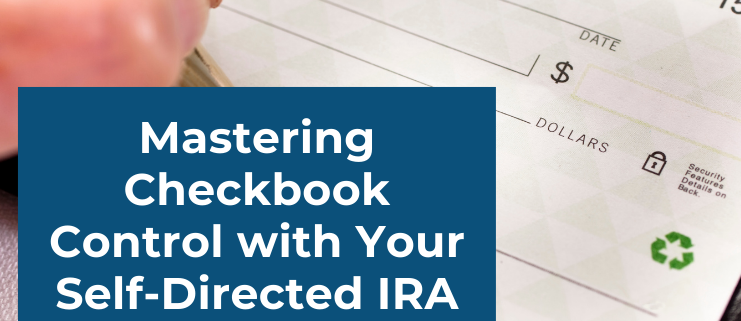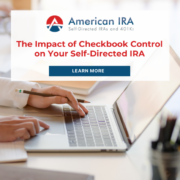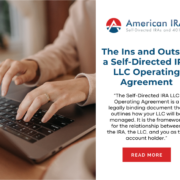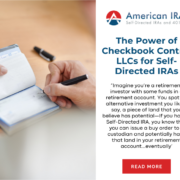Mastering Checkbook Control with Your Self-Directed IRA
A checkbook within an LLC. An LLC within an IRA. Investing within the IRA when you have the power of the checkbook. It’s really that simple, once you get down to the nuts and bolts. But mastering checkbook control with your Self-Directed IRA can be more complicated than that. So let’s look at some more advanced tips for understanding, managing, and setting up checkbook control so you feel empowered as an investor.
Understanding Checkbook Control Before You Master It
Let’s zoom in. Checkbook control means that you, as the account holder, have direct authority over the funds in your Self-Directed IRA. Instead of needing custodian approval for each investment transaction, you can use a checking account established under your IRA LLC to write checks or transfer funds for investments. It’s a process that requires some additional steps when you set it up. But once you do, investing via checkbook control can be easier to manage—and it can give you more flexibility as well.
Setting Up a Self-Directed IRA LLC
To gain checkbook control, you need to set up a Self-Directed IRA LLC. This requires a couple of steps. First, you’ll need a Self-Directed IRA. This involves choosing a custodian who will facilitate the establishment of your Self-Directed IRA and transfer your funds into the LLC. Once the IRA is in place, you will form the LLC, ideally with the help of legal and financial professionals. After establishing the LLC, you will open a checking account in its name. That’s what gives you “checkbook control.” You can now use this account for all transactions related to your IRA investments. And as a result, you can manage your investments more directly.
The Benefits of Your Checkbook Control
Mastering checkbook control offers several advantages. First, you’ll gain direct access to your investment capital. See an opportunity? You can execute a trade on it as soon as you can write the check. No direct custodial approval required. This approach helps you jump on opportunities as you see them. And since it’s a Self-Directed IRA, you can always explore a wider array of assets: real estate, private equity, and other alternative investments.
Avoiding Common Pitfalls and Mistakes with Checkbook Control
While checkbook control provides all sorts of benefits, you’ll have to know some common mistakes to avoid. For starters, make sure all your investments comply with IRS regulations to avoid prohibited transactions—you can’t use this checkbook to invest in wine and call it a retirement asset. Collectibles aren’t valid retirement assets, which means this would be an invalid transaction. And accurate record-keeping is crucial, so maintain detailed records of all transactions, including receipts and bank statements, for compliance and tax reporting.
Managing Investments Effectively
To make the most of checkbook control, develop a clear investment strategy that aligns with your retirement goals. You’re the one in charge, after all. Apply scrutiny to your own strategies. Regularly review your portfolio to monitor performance and make necessary adjustments. Consulting with financial advisors, tax professionals, and legal experts can help you handle the complex issues you come across.
Mastering checkbook control with your Self-Directed IRA can be a major shot in the arm for your investment strategy, providing direct access to your funds and greater control over your investment decisions. But it helps to know how to manage it, too. The first step is to reach out to a Self-Directed IRA administration firm who can help you get started with the IRA. From there, it’s a simple matter of setting up the LLC and structuring your investments to work for your unique style.
Interested in learning more about Self-Directed IRAs? Contact American IRA, LLC at 866-7500-IRA (472) for a free consultation. Download our free guides or visit us online at www.AmericanIRA.com.











